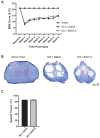Early Detrusor Application of Botulinum Toxin A Results in Reduced Bladder Hypertrophy and Fibrosis after Spinal Cord Injury in a Rodent Model
- PMID: 36356027
- PMCID: PMC9697114
- DOI: 10.3390/toxins14110777
Early Detrusor Application of Botulinum Toxin A Results in Reduced Bladder Hypertrophy and Fibrosis after Spinal Cord Injury in a Rodent Model
Abstract
Following spinal cord injury (SCI), pathological reflexes develop that result in altered bladder function and sphincter dis-coordination, with accompanying changes in the detrusor. Bladder chemodenervation is known to ablate the pathological reflexes, but the resultant effects on the bladder tissue are poorly defined. In a rodent model of contusion SCI, we examined the effect of early bladder chemodenervation with botulinum toxin A (BoNT-A) on bladder histopathology and collagen deposition. Adult female Long Evans rats were given a severe contusion SCI at spinal level T9. The SCI rats immediately underwent open laparotomy and received detrusor injections of either BoNT-A (10 U/animal) or saline. At eight weeks post injury, the bladders were collected, weighed, and examined histologically. BoNT-A injected bladders of SCI rats (SCI + BoNT-A) weighed significantly less than saline injected bladders of SCI rats (SCI + saline) (241 ± 25 mg vs. 183 ± 42 mg; p < 0.05). Histological analyses showed that SCI resulted in significantly thicker bladder walls due to detrusor hypertrophy and fibrosis compared to bladders from uninjured animals (339 ± 89.0 μm vs. 193 ± 47.9 μm; p < 0.0001). SCI + BoNT-A animals had significantly thinner bladder walls compared to SCI + saline animals (202 ± 55.4 μm vs. 339 ± 89.0 μm; p < 0.0001). SCI + BoNT-A animals had collagen organization in the bladder walls similar to that of uninjured animals. Detrusor chemodenervation soon after SCI appears to preserve bladder tissue integrity by reducing the development of detrusor fibrosis and hypertrophy associated with SCI.
Keywords: bladder hypertrophy; botulinum toxin; spinal cord injury.
Conflict of interest statement
The authors declare no conflict of interest.
Figures





Similar articles
-
Botulinum toxin type A normalizes alterations in urothelial ATP and NO release induced by chronic spinal cord injury.Neurochem Int. 2008 May;52(6):1068-75. doi: 10.1016/j.neuint.2007.11.006. Epub 2007 Nov 26. Neurochem Int. 2008. PMID: 18187233 Free PMC article.
-
Clinical Efficacy and Changes of Urothelial Dysfunction after Repeated Detrusor Botulinum Toxin A Injections in Chronic Spinal Cord-Injured Bladder.Toxins (Basel). 2016 May 30;8(6):164. doi: 10.3390/toxins8060164. Toxins (Basel). 2016. PMID: 27249005 Free PMC article. Clinical Trial.
-
Acute Chemodenervation of the Bladder With Botulinum Toxin After Spinal Cord Injury Resulted in Preserved Bladder Function in Rodents.Neurourol Urodyn. 2025 Jul 30. doi: 10.1002/nau.70124. Online ahead of print. Neurourol Urodyn. 2025. PMID: 40735928
-
Meta-analysis of botulinum toxin A detrusor injections in the treatment of neurogenic detrusor overactivity after spinal cord injury.Arch Phys Med Rehabil. 2013 Aug;94(8):1473-81. doi: 10.1016/j.apmr.2013.04.011. Epub 2013 Apr 28. Arch Phys Med Rehabil. 2013. PMID: 23632286 Review.
-
Treating Neurogenic Lower Urinary Tract Dysfunction in Chronic Spinal Cord Injury Patients-When Intravesical Botox Injection or Urethral Botox Injection Are Indicated.Toxins (Basel). 2023 Apr 17;15(4):288. doi: 10.3390/toxins15040288. Toxins (Basel). 2023. PMID: 37104226 Free PMC article. Review.
Cited by
-
Onabotulinum Toxin A Intradetrusor Injections in Children with Neurogenic Lower Urinary Tract Dysfunction: Long-Term Histological Effects on the Bladder Wall.Biomedicines. 2023 Apr 27;11(5):1300. doi: 10.3390/biomedicines11051300. Biomedicines. 2023. PMID: 37238971 Free PMC article.
-
Expression profiles of circular RNAs and interaction networks of competing endogenous RNAs in neurogenic bladder of rats following suprasacral spinal cord injury.PeerJ. 2023 Sep 18;11:e16042. doi: 10.7717/peerj.16042. eCollection 2023. PeerJ. 2023. PMID: 37744239 Free PMC article.
-
Translational Pitfalls in SCI Bladder Research: The Hidden Role of Urinary Drainage Techniques in the Rat Model.Biology (Basel). 2025 Jul 23;14(8):928. doi: 10.3390/biology14080928. Biology (Basel). 2025. PMID: 40906068 Free PMC article.
-
Long-Term Adherence to Onabotulinum Toxin-A Intradetrusor Injections for Neurogenic Dysfunction in Children-A Retrospective Single-Center Evaluation.Toxins (Basel). 2024 Jul 1;16(7):303. doi: 10.3390/toxins16070303. Toxins (Basel). 2024. PMID: 39057943 Free PMC article.
-
Inhibition of the NF-κB Signaling Pathway Alleviates Pyroptosis in Bladder Epithelial Cells and Neurogenic Bladder Fibrosis.Int J Mol Sci. 2023 Jul 6;24(13):11160. doi: 10.3390/ijms241311160. Int J Mol Sci. 2023. PMID: 37446339 Free PMC article.
References
-
- Comperat E., Reitz A., Delcourt A., Capron F., Denys P., Chartier-Kastler E. Histologic features in the urinary bladder wall affected from neurogenic overactivity—A comparison of inflammation, oedema and fibrosis with and without injection of botulinum toxin type A. Eur. Urol. 2006;50:1058–1064. doi: 10.1016/j.eururo.2006.01.025. - DOI - PubMed
Publication types
MeSH terms
Substances
LinkOut - more resources
Full Text Sources
Medical

